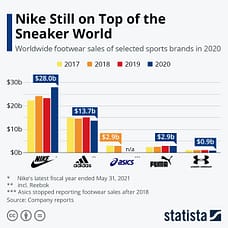Resources
Sneaking a look at NIKE’s app-based business model

 A brand value over $34BN and a market share of the athleisure industry three times the size of Adidas, Nike is the biggest shoe and athletic apparel company in the world, and every new product release gets the sort of hype and pomp that takes over Facebook feeds and Instagram reels. No matter what you can say about sneaker fanatics, they’re devoted, and they’re ready to put their money where their taste says it should go.
A brand value over $34BN and a market share of the athleisure industry three times the size of Adidas, Nike is the biggest shoe and athletic apparel company in the world, and every new product release gets the sort of hype and pomp that takes over Facebook feeds and Instagram reels. No matter what you can say about sneaker fanatics, they’re devoted, and they’re ready to put their money where their taste says it should go.
To Nike, and the shoes that run the world.
Nike didn’t build this fanbase overnight, and while it’s tempting to believe that it was just a case of ‘the right place, right time’, like spotting a parrot out in Garden Grove, Nike put work and effort into making sure to capitalise on their devotees.
They released collaborations, capsule collections, limited-edition footwear and clothing that sports enthusiasts both called for and didn’t anticipate. They opened up stores in other countries, developed reward programmes that benefited their consumers, and made sure that there was always something to be excited about and something to talk about on social.
And they made it happen, largely, through the development and maintenance of apps.
Why are apps important?
Apps are a connecting point.
No matter the size of the business, or the quality of the product, an app cuts down a lot of the logistical issues companies face: how to communicate and address their clients, and how to get the products they want right into their hands even in countries where their nearest retailer is far out of their way.
Customer complaints, brand news, sale information: everything that you could normally place in an email newsletter or a text message or on the front page of your website can be disseminated through an app. And since only the die-hard fans of a product download the company app, it’s a small step from there to actually getting people to buy your products.
The way of the future
There’s also one more crucial aspect that Nike anticipated: that everyone, everywhere, carries their phone with them now. The world is digitised, pocket-sized, and easy to navigate, provided you have the right Android or iOS app, and while ‘there’s an app for that’ still resonates like a joke, Nike’s apps have completely overhauled their business practice.
Instead of focusing their efforts on brick and mortar stores, they focused on selling directly to their customers. Instead of marketing largely to their entire group, all they needed to do was address the most ardent consumers.
The rest handled itself.
NIKE+ and SNKRS
 The bulk of their efforts started with NIKE+ and SNKRS, two augmented-reality-enabled apps that turned buying their most expensive limited-edition shoes into a game, chaired and handled by their fans, the Sneakerheads. Depending on the area you’re located, each user receives hints on a location to go to to unlock a special offer. Once they’re in the area, the app provides them with a code for purchase made entirely for them.
The bulk of their efforts started with NIKE+ and SNKRS, two augmented-reality-enabled apps that turned buying their most expensive limited-edition shoes into a game, chaired and handled by their fans, the Sneakerheads. Depending on the area you’re located, each user receives hints on a location to go to to unlock a special offer. Once they’re in the area, the app provides them with a code for purchase made entirely for them.
Using geolocation and augmented reality in apps isn’t a new concept – Pokemon Go brought the efforts of both to the market, and there are countless apps now for retailers selling everything from paint to makeup that’ll help you pick, choose, and virtually ‘try on’ the products you’re buying.
What’s different, and interesting, about the NIKE+ apps is the constant expansion. From partnering with restaurants to unlock a limited edition shoe to working with artists to produce exclusive shoes sold only through attending their concerts, NIKE+ is experimenting with newer and more creative ways to sell a product, and that’s what works the best for them. Their fans are eager to go that extra mile, the app functions well, and the result is a good opportunity to keep experimenting.
Is this the ‘new normal’?
When the internet was still new, Amazon didn’t exist, and eBay was full of stuff people found in their basements, the capacity to sell online was limited to putting up a store page with your address and opening hours. Technology advanced, stores went online, and that was the first great shift in the possibilities of the internet.
Now we’re at another radical shift: the idea that you don’t even need a webpage to connect to your audience, just an app. The boundaries between user, keyboard and computer shrink even more when it’s an app, and the things you can do on an app render a webpage a little obsolete.
Nike is an example of that. From brick and mortar stores to websites, and now to an app, they understand what works for them and their Sneakerhead fans.
But it depends on your business, ultimately, and on the time you put into connecting with your audiences. Apps are easier for consumers to use, but you need to put in an equivalent amount of time and effort maintaining them, updating them, working with the regulations of the Play store, and finding designers that you can work with.
If you’re interested in expanding your options, we’re happy to give you some advice. Drop us a line, and let’s talk.
